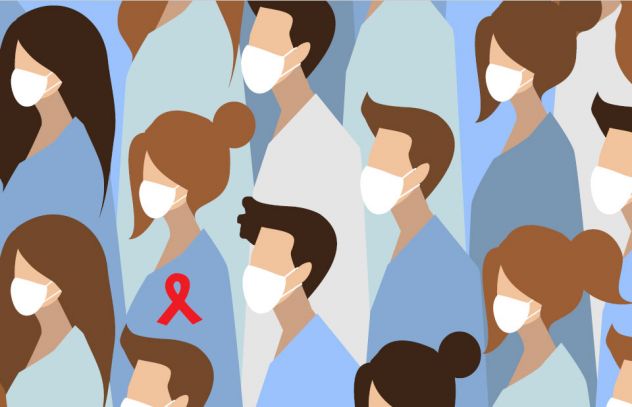HIV予防連合は2017年10月、国連合同エイズ計画(UNAIDS)と国連人口基金(UNFPA)が中心になって結成し、国連加盟国やHIV予防関連の市民社会組織、国際組織などがパートナーとして参加しています。HIVの流行が深刻な28カ国に焦点を当てて、2020年までに高速対応目標の90-90-90ターゲットを達成し、HIVの新規感染を75%減らすことを目指していました。
残念ながら90-90-90ターゲットの達成は果たせませんでしたが、2021年以降も引き続きHIV予防対策に取り組んでおり、7月1日にはCOVID-19の流行が与えたHIV予防対策への影響とその対応をまとめた報告書『新たなパンデミック期におけるHIV感染予防』を発表しています。その報告書を紹介したUNAIDS公式サイトのフィーチャーストーリーを日本語に訳しました。英文はこちらでご覧ください。
報告書は《2020年のCOVID-19パンデミックの間にHIV対策が経験したプログラムの混乱と事態への対応をまとめた統合報告書で、HIV予防プログラムが置かれた状況を総括し、その弱点とリスク、サービスの中断状況などを把握するとともに、対応策についても記録しています》ということです。以下、報告書そのものではなく、フィーチャーストーリーの日本語仮訳です。

COVID-19の流行によるHIV予防対策の混乱は大きかったものの、サービスの改革で対応は可能 HIV予防連合報告書が強調
2021年7月1日、UNAIDSフィーチャーストーリー
COVID-19のパンデミックにより、十年以上にわたってHIV/エイズ対策が何とか達成してきた公衆衛生の成果も脅威にさらされています。その中でHIV陽性者やHIVに影響を受けている人たちが、COVID-19パンデミックついて必要な情報と支援を確実に受けられるようにする極めて重要な役割をUNAIDSは担っています。また、HIV予防・治療サービスが途切れることなく利用するために必要な手段の開発と支援も進めています。
2017年に発足した世界HIV予防連合(GHPC)は、HIVの流行から最も大きく影響を受けてきた28カ国に焦点を当て、HIV予防対策に新たな勢いを生み出すためのより明確な方向性を示すことを目指しています。7月1日には報告書『新たなパンデミック期におけるHIV感染予防』を発表しました。2020年のCOVID-19パンデミックの間にHIV対策が経験したプログラムの混乱と事態への対応をまとめた統合報告書で、HIV予防プログラムが置かれた状況を総括し、その弱点とリスク、サービスの中断状況などを把握するとともに、対応策についても記録しています。報告書はとくにコミュニティレベルのプログラム改革に重点を置き、情報収集を進めました。
UNAIDSのシャノン・ハイダー事務局次長(プログラム担当)は「年間の新規HIV感染が2010年当時と比べると23%減少しています。HIV予防は苦労を重ね大きな成果を上げてきました。COVID-19パンデミックによって、その努力が台無しになるおそれがあります。HIVの新規感染をさらに減らしていく努力が必要な時期にこういうことになってしまったのです。成果を阻んでいるギャップは、社会の中に大きな不平等が存在することを示しています。COVID-19がもたらすHIV予防サービスへの影響は極端に大きく、キーポピュレーションや思春期の少女、若い女性など最も取り残された人たちが不釣り合いに大きな社会的障壁の影響を受けているのです」と話しています。
必然的に、HIV予防サービスは大きく混乱し、コンドーム、潤滑剤、抗レトロウイルス薬など重要なHIV予防用品のサプライチェーンは限界に達しようとしています。自発的男性器包皮切除の件数が前年同月比で大きく減少するなど、COVID-19の流行初期の数カ月で重要なHIV予防プログラムを受ける人の数が落ち込んでいることも報告書には反映されています。同時にCOVID-19は、社会の不平等と保健分野の不公正をはっきりと示し、拡大させる一方で、医療その他の公的制度がエイズ流行終結に向けた課題を克服するため、より公平かつ包摂的に対応する方法も示しました。保健医療提供者とコミュニティ組織はHIV予防サービスの提供方法を変え、重要なサービスの中断を最小限に抑えることで、危機に対処してきたのです。
報告書は、COVID-19の影響を緩和するための革新的方策、およびそれをHIVサービスにどう適応させるかという課題に焦点を当てています。数カ月間使用できるだけの量のコンドームと潤滑剤、注射針・注射器の配付、曝露前予防(PrEP)のための抗レトロウイルス薬の複数月調剤、利用者の事情に合わせた分化型サービスの提供、自己検査の普及、予防用品配付のための代替アクセスポイントの開設などが含まれます。対象となる予防用品はコンドームや曝露前予防(PrEP)、注射薬物使用者のオピオイド代替療法のための持ち帰り用代替薬などです、また、キーポピュレーションや思春期の少女・若い女性のためのアウトリーチサービスの継続に向けた安全性の確保、予防対策のための仮想プラットフォーム開設なども革新的な方策に含まれます。これらの対策は、 COVID-19パンデミックに対応するだけでなく、当面の課題解決を超えて規模拡大を進めていく必要があります。報告書はさらに、COVID-19のパンデミック対策が、HIV分野の専門家やコミュニティの教訓を生かして、早期に決然とした行動をとり、弱い立場の人たちへの対応と医療サービスの維持に向けて2つのパンデミック対策の相乗効果を高めていったことも強調しています。
「30年以上にわたって効果の高いHIV予防対策を追求してきたことで、低・中所得国の政策決定者および保健プログラムの実施者が新型コロナウイルス(SARS-CoV-2)の感染予防に最善の選択をするための豊富な知識と経験も獲得できました」とハイダー事務局次長は述べています。「コミュニティから届く最も差し迫ったニーズは、生計の維持です。どうすれば、食事を確保し、生活し、自らのケアを続けながら、COVID-19の流行の中で生き残れるのでしょうか。UNAIDSはそのために必要なサービスと人びととの仲立ちをすることができます」と彼女は付け加えました。
報告書は、世界エイズ・結核・マラリア対策基金(グローバルファンド)のCOVID-19対応メカニズムから助成を受けようとするすべての利害関係者のために提案書作成チームを編成し、準備作業の支援にあたることを明らかにしています。世界のHIV予防対策が勢いを取り戻し、COVID-19パンデミックによる影響を軽減するには、HIV予防対策のさらなる改革を支援し、規模拡大をはかる必要があるからです。
Feature Story
Report shows big COVID-19-related HIV prevention programme service disruptions, but highlights that HIV service innovations and adaptations are possible
01 JULY 2021
The COVID-19 pandemic is threatening decades of hard-won development and public health gains. UNAIDS is committed to playing a pivotal role in ensuring that people living with and affected by HIV have the information and support they need during the COVID-19 pandemic and is promoting the development and support measures needed to ensure that access to HIV prevention and treatment services continues uninterrupted.
Launched in 2017, the Global HIV Prevention Coalition aims to bring fresh momentum and clarity to HIV prevention programmes, focusing on 28 countries carrying the highest burden of the HIV epidemic. The Global HIV Prevention Coalition has published a new report, Preventing HIV infections at the time of a new pandemic: a synthesis report on programme disruptions and adaptations during the COVID-19 pandemic in 2020, which provides a synthesis of the status of HIV prevention programming during the COVID-19 pandemic, identifies critical vulnerabilities, risks and major service disruptions and documents responses in a range of settings. The report places a significant focus on gathering information on programme innovations at the community level.
“The COVID-19 pandemic risks reversing the hard-won gains made in HIV prevention, including the 23% reduction in new infections since 2010. And this is at a time when much more still needs to be done to drastically reduce new HIV infections. Gaps and threats to progress show great inequalities, and HIV prevention services and societal barriers for the people most left behind, such as key populations and adolescent girls and young women, have been disproportionately impacted by COVID-19,” said Shannon Hader, the UNAIDS Deputy Executive Director for Programmes.
Inevitably, significant disruptions on HIV prevention services have been observed, and supply chains for crucial HIV prevention commodities, including condoms, lubricants and antiretroviral and other medicines, have been stretched. The report reflects on the early dips observed in the monthly numbers of people served by critical HIV prevention programmes, including huge drops in the number of voluntary medical male circumcisions performed compared to previous corresponding months.
At the same time, while it has vividly exposed and widened inequalities and health inequities, COVID-19 has also shown how to make health systems and other public institutions fairer, more inclusive and better able to meet the challenges of ending the AIDS epidemic. Health-service providers and community organizations have responded to the crisis by changing how they provide HIV prevention services and minimizing disruptions of essential services.
The report highlights COVID-19 impact mitigation innovations and adaptations of HIV services, including multimonth dispensing of condoms, lubricants, needles, syringes and pre-exposure prophylaxis (PrEP), differentiated service delivery and self-testing approaches, alternative access points for prevention commodities such as condoms and PrEP, take-home dosages of opioid substitution therapy for people who inject drugs, the safe continuation of outreach services for key populations and adolescent girls and young women and virtual platforms for prevention interventions—and calls for their scale-up even beyond the COVID-19 pandemic. The report further highlights how the COVID-19 pandemic response has drawn from HIV experts and communities and has taken early decisive action to address critical vulnerabilities, maintain health services and build synergies between the colliding pandemics.
“In over 30 years of developing effective prevention approaches, we have gained substantial knowledge and experience that decision-makers and health programme implementers can use in low- and middle-income countries to make the best possible choices in preventing SARS-CoV-2,” said Dr Hader. “The most pressing needs we hear from communities are the protection of livelihoods: how do people eat, live, care for themselves and survive COVID-19? UNAIDS can help broker services for people,” she added.
The report will support all stakeholders in their preparation of Global Fund to Fight AIDS, Tuberculosis and Malaria COVID-19 Response Mechanism applications, ensuring that proposal writing teams identify key HIV prevention innovations and adaptations that could be supported and scaled-up to regain global HIV prevention momentum and mitigate the impact of the COVID-19 pandemic on HIV services.